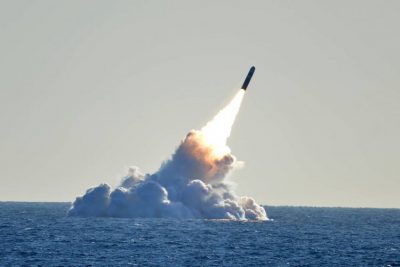Australia and the Road to Nuclear War

All Global Research articles can be read in 51 languages by activating the “Translate Website” drop down menu on the top banner of our home page (Desktop version).
To receive Global Research’s Daily Newsletter (selected articles), click here.
Follow us on Instagram and Twitter and subscribe to our Telegram Channel. Feel free to repost and share widely Global Research articles.
***
Australia’s pledge to play its part in the United States’ drive to war in the Indo-Pacific means it is hardly a surprise for China to voice its concerns.
The Australia, United Kingdom and United States (AUKUS) agreement, alongside the anti-China Quadrilateral Security Dialogue (Quad) alliance of the US, India, Japan and Australia, can only be seen as a threat to China.
China is particularly critical of AUKUS’s commitments to new bases, long-range strike capability and especially the nuclear submarine deal for Australia. AUKUS opens the door for the North Atlantic Treaty Organisation (NATO) to expand into the Indo-Pacific.
The China Arms Control and Disarmament Association (CACDA) and the China Institute of Nuclear Industry Strategy (CINIS), issued a joint report on July 22, titled The nuclear proliferation risk of the nuclear-powered submarines collaboration in the context of AUKUS.
It argues that the AUKUS nuclear-powered submarine collaboration violates the Treaty on the Non-Proliferation of Nuclear Weapons, as it contributes to the nuclear build-up in the region.
Canberra has rejected this argument, although it has also been put by a number of peace organisations, including the US-based Carnegie Endowment for International Peace, think tanks including the Lowy Institute, as well as anti-war organisations in Australia.
It is anticipated that, under AUKUS, the US and Britain will provide Australia with eight nuclear-powered submarines, involving the transfer of tonnes of weapons-grade nuclear materials.
Cathy Moloney writes in The Interpreter that “the naval reactor has long been seen as a loophole to the NPT and [International Atomic Energy Agency] IAEA safeguards, whereby a [non-nuclear weapons state] NNWS could divert materials from naval reactors and potentially use that material for weapons production”.
The Chinese report said the AUKUS nuclear-powered submarine collaboration serves a military purpose, in violation of the IAEA.
AUKUS allows the US and Britain to provide Australia with long-range precision-strike capabilities, including Tomahawk cruise missiles, which can be nuclear-armed.
China’s criticism that AUKUS is provocative is valid, especially in light of the US’ broader military build-up in the region.
The US Indo-Pacific Command (also known as USINDOPACOM) has 200 naval ships, including 5 aircraft carrier strike groups, 1100 aircraft and 375,000 military personnel permanently stationed in the region. It has a string of bases and installations from Japan to Australia. Further arming the region can only lead to a regional arms race as part of the new cold war.
The ABC’s foreign affairs reporter Stephen Dziedzic cited “government sources” arguing that Australia has no intention of acquiring nuclear weapons. “Australia’s decision to acquire conventionally armed, nuclear-powered submarines is something we are pursuing openly and transparently,” the source told the ABC.
Former US National Security Chief Michael Rogers on a visit to Australia addressed the “threat” from Russia and China at the National Press Club on July 21 where he put the case for Australia’s on-going commitment to the US alliance.
The former admiral said that as both countries are members of the Quad and AUKUS, regardless of economic difficulties, global fuel prices or inflation worries, the Australia-US alliance would have to deal with challenges in a unified manner.
Rogers had no need to beat any drums: the frequent visits to Washington by the previous Coalition and now the Labor government make it clear the line is set.
Admiral John C Aquilino, Commander of the US Indo-Pacific Command, made a special visit to Australia days before the federal election. He and Angus Campbell, Chief of the Australian Defence Force General, issued a joint statement afterwards speaking of “plans for enhanced air, maritime, land and logistics force posture cooperation” and how this “will strengthen our ability to operate as a combined force and to train and deploy with our partners in the region to advance collective security and integrated deterrence”.
Aquilino visited Amberly RAAF air base near Brisbane, describing to the Financial Times how the Northrop B-2 Spirit stealth bomber “had flown in from the US to demonstrate American long-range military power to potential adversaries”. It is nuclear capable.
Aquilino made no bones about how his Indo-Pacific Command was working closely with the US Strategic Command to provide “an integrated deterrence” to be used against China.
The ABC’s defence correspondent saw fit to accuse China of making “outlandish” claims about Australia’s pursuit of nuclear weapons. But nuclear-capable US aircraft, Tomahawk Cruise missiles on Australian vessels, nuclear submarines and the integration of NATO in to the Indo-Pacific all point in one direction.
*
Note to readers: Please click the share buttons above or below. Follow us on Instagram and Twitter and subscribe to our Telegram Channel. Feel free to repost and share widely Global Research articles.
Featured image: A trident 11 D5 missile being launched from a US submarine. Photo: US Army/Wikipeadia

